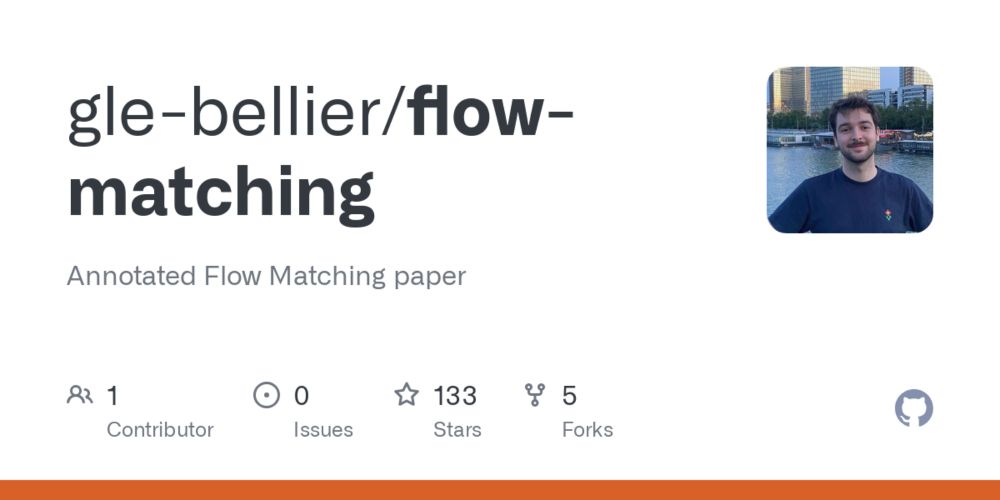
Previously intern @SonyCSL, @Ircam, @Inria
🌎 Personal website: https://lebellig.github.io/

1. Annotated Flow Matching paper: github.com/gle-bellier/...
2. Discrete Flow Matching: github.com/gle-bellier/...
3. Minimal FM in Jax: github.com/gle-bellier/...
Tianhong Li & Kaiming He arxiv.org/abs/2511.13720
Diffusion models in pixel-space, without VAE, with clean image prediction = nice generation results. Not a new framework but a nice exploration of the design space of the diffusion models.



Tianhong Li & Kaiming He arxiv.org/abs/2511.13720
Diffusion models in pixel-space, without VAE, with clean image prediction = nice generation results. Not a new framework but a nice exploration of the design space of the diffusion models.



Tianhong Li & Kaiming He arxiv.org/abs/2511.13720
Diffusion models in pixel-space, without VAE, with clean image prediction = nice generation results. Not a new framework but a nice exploration of the design space of the diffusion models.
youtu.be/YRJRgmXV8_I?...

youtu.be/YRJRgmXV8_I?...
Solving the Schrödinger bridge pb with a non-zero drift ref. process: learn curved interpolants, apply minibatch OT with the induced metric, learn the mixture of diffusion bridges.




Solving the Schrödinger bridge pb with a non-zero drift ref. process: learn curved interpolants, apply minibatch OT with the induced metric, learn the mixture of diffusion bridges.
aiscienceconference.caltech.edu

aiscienceconference.caltech.edu
Transport between two distributions defined on different spaces by training a noise-to-data flow models in the target space, conditioned on the source data and leveraging Gromov–Wasserstein couplings

Transport between two distributions defined on different spaces by training a noise-to-data flow models in the target space, conditioned on the source data and leveraging Gromov–Wasserstein couplings
We are excited to join an ecosystem of great open-source AI libraries, including @hf.co diffusers, MONAI, einops, etc.
pytorch.org/blog/deepinv...
We are excited to join an ecosystem of great open-source AI libraries, including @hf.co diffusers, MONAI, einops, etc.
pytorch.org/blog/deepinv...
Are FM & diffusion models nothing else than denoisers at every noise level?
In theory yes, *if trained optimally*. But in practice, do all noise level equally matter?
with @annegnx.bsky.social, S Martin & R Gribonval
Are FM & diffusion models nothing else than denoisers at every noise level?
In theory yes, *if trained optimally*. But in practice, do all noise level equally matter?
with @annegnx.bsky.social, S Martin & R Gribonval
I'm looking for:
🧑💻 an intern on generative models for change detection
🧑🔬 a PhD student on neurosymbolic generative models for geospatial data
Both starting beginning of 2026.
Details are below, feel free to email me!
I'm looking for:
🧑💻 an intern on generative models for change detection
🧑🔬 a PhD student on neurosymbolic generative models for geospatial data
Both starting beginning of 2026.
Details are below, feel free to email me!
- 19x faster convergence ⚡
- 370x less FLOPS than FLUX-dev 📉

- 19x faster convergence ⚡
- 370x less FLOPS than FLUX-dev 📉
Transport between two distributions defined on different spaces by training a noise-to-data flow models in the target space, conditioned on the source data and leveraging Gromov–Wasserstein couplings

Transport between two distributions defined on different spaces by training a noise-to-data flow models in the target space, conditioned on the source data and leveraging Gromov–Wasserstein couplings
arxiv.org/abs/2510.21686

arxiv.org/abs/2510.21686
It might not be the easiest intro to diffusion models, but this monograph is an amazing deep dive into the math behind them and all the nuances

It might not be the easiest intro to diffusion models, but this monograph is an amazing deep dive into the math behind them and all the nuances
⭐️repo: github.com/JaxionProjec...
📚docs: jaxion.readthedocs.io
Feedback + collaborations welcome!
⭐️repo: github.com/JaxionProjec...
📚docs: jaxion.readthedocs.io
Feedback + collaborations welcome!
We use score matching and a trick from quantum field theory to make a product-of-experts family both expressive and efficient for variational inference.
To appear as a spotlight @ NeurIPS 2025.
#NeurIPS2025 (link below)

We use score matching and a trick from quantum field theory to make a product-of-experts family both expressive and efficient for variational inference.
To appear as a spotlight @ NeurIPS 2025.
#NeurIPS2025 (link below)


Broadcast available at gdr-iasis.cnrs.fr/reunions/mod...


Broadcast available at gdr-iasis.cnrs.fr/reunions/mod...
tinyurl.com/Samudrace

tinyurl.com/Samudrace
Unexpected result: swapping the SD-VAE for a pretrained visual encoder improves FID, challenging the idea that encoders' information compression is not suited for generative modeling!



